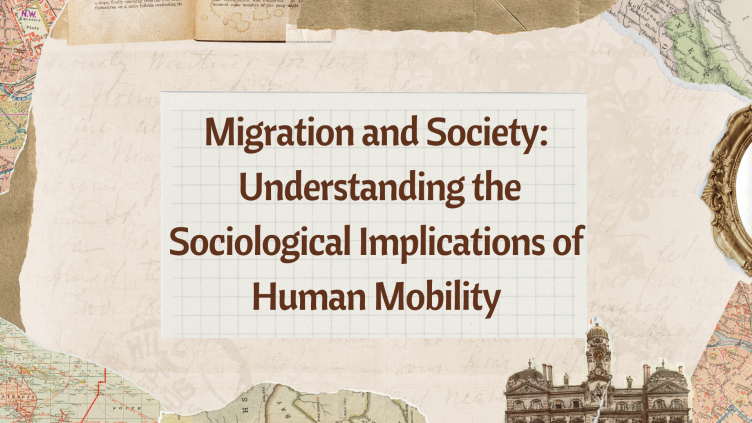Migration is as old as humanity itself. From our earliest ancestors who ventured out of Africa to populate the globe, to modern-day movements influenced by globalization, migration shapes societies in profound ways. Today, understanding the sociological implications of human mobility is crucial, given its increasing relevance in our interconnected world. This article delves into the multifaceted nature of migration, examining its impacts on communities, economies, and individual lives, while providing real-world examples to highlight its contemporary significance.
The Historical Context of Migration
Migration is not a new phenomenon. Throughout history, humans have moved in search of better living conditions, resources, and opportunities. The Great Migration of African Americans in the early 20th century, for instance, saw millions move from the rural South to the urban North in the United States, seeking economic opportunities and escaping racial segregation. This movement had lasting impacts on American culture, politics, and demographics.
Similarly, the European colonization of the Americas in the 15th and 16th centuries led to significant demographic shifts, with indigenous populations drastically declining due to disease and conflict, while European settlers established new societies. These historical migrations underscore the transformative power of human mobility.
Drivers of Migration
Understanding why people migrate is key to grasping its sociological implications. Migration can be driven by various factors, including:
- Economic Opportunities: Many individuals and families move to seek better job prospects and improve their standard of living. For example, the migration of Indian IT professionals to Silicon Valley has contributed to the technological boom in the United States.
- Political Instability: Conflicts, persecution, and unstable political environments force people to flee their homes. The Syrian refugee crisis, which began in 2011, saw millions of Syrians displaced by civil war, seeking asylum in Europe and neighboring countries.
- Environmental Factors: Climate change and natural disasters can displace populations. The Pacific island nation of Tuvalu faces the threat of becoming uninhabitable due to rising sea levels, prompting discussions about climate-induced migration.
- Social and Cultural Reasons: Family reunification, education, and cultural exchanges also drive migration. International students studying abroad, for example, contribute to cultural diversity and knowledge exchange.
Sociological Implications of Migration
Migration impacts societies in numerous ways, influencing demographics, economies, and social structures. Here are some key sociological implications:
Demographic Changes
Migration alters the demographic composition of both sending and receiving regions. In receiving countries, immigrants can rejuvenate aging populations and contribute to workforce diversity. For instance, Germany’s decision to accept over a million refugees during the 2015 crisis helped address its demographic challenges, such as an aging population and labor shortages.
Conversely, sending countries may experience a ‘brain drain,’ where the emigration of skilled professionals hampers economic development. However, remittances sent back home by migrants can offset some of these challenges by boosting local economies. The Philippines, for example, receives billions of dollars annually from its overseas workers, significantly contributing to its GDP.
Economic Impacts
Migrants play a vital role in the economies of their host countries. They often fill labor market gaps, undertake jobs locals may not want, and contribute to innovation and entrepreneurship. The success of Silicon Valley is partly attributed to immigrant entrepreneurs who have founded numerous tech startups, driving economic growth and technological advancements.
However, migration can also create economic challenges, such as competition for jobs and strain on public services. Balancing these dynamics requires thoughtful immigration policies that integrate migrants into the economy while addressing potential societal tensions.
Cultural and Social Integration
The cultural diversity brought by migration enriches societies, fostering innovation, creativity, and cross-cultural understanding. Cities like London, New York, and Toronto are celebrated for their multicultural vibrancy, where diverse cuisines, traditions, and festivals thrive.
Nevertheless, integration is not always smooth. Migrants may face discrimination, language barriers, and cultural differences that hinder their inclusion. Effective integration policies, such as language courses, community engagement programs, and anti-discrimination measures, are essential for building cohesive societies.
Social Networks and Transnationalism
Migrants often maintain strong connections with their home countries, creating transnational networks that span borders. These networks facilitate the exchange of ideas, culture, and resources, influencing both sending and receiving societies. For example, the Indian diaspora in the United States has played a significant role in fostering bilateral relations and cultural exchange between the two countries.
Social media and digital communication have further strengthened these transnational ties, enabling migrants to stay connected with their families and communities back home, while also participating in the social and political life of their host countries.
Contemporary Relevance of Migration
In today’s globalized world, migration is more relevant than ever. Several current trends and issues highlight the importance of understanding its sociological implications:
Globalization and Labor Mobility
Globalization has facilitated the movement of goods, services, and people across borders. Labor mobility is essential for addressing global labor market imbalances and meeting the demand for skilled workers in various industries. The COVID-19 pandemic underscored the importance of migrant workers, as many essential sectors, such as healthcare and agriculture, rely heavily on immigrant labor.
Refugee Crises and Humanitarian Challenges
Ongoing conflicts and humanitarian crises continue to displace millions of people worldwide. Addressing the needs of refugees and asylum seekers requires international cooperation and comprehensive policies that ensure their protection and integration. The response to the Ukrainian refugee crisis following Russia’s invasion in 2022 is a testament to the global community’s ability to mobilize support for displaced populations.
Climate Change and Environmental Migration
Climate change is expected to intensify migration patterns as people are forced to leave their homes due to rising sea levels, extreme weather events, and resource scarcity. Addressing climate-induced migration requires proactive measures, including sustainable development, disaster preparedness, and international frameworks that protect climate migrants.
Technological Advancements and Digital Migration
Technological advancements have transformed the migration experience. Digital platforms facilitate job searches, language learning, and social integration for migrants. Moreover, the rise of remote work allows individuals to live and work from anywhere, creating new forms of digital migration. This trend offers opportunities for economic development in regions previously excluded from global labor markets.
Conclusion
Migration is a complex and multifaceted phenomenon with profound sociological implications. Understanding these implications is essential for creating inclusive, resilient, and dynamic societies. As migration continues to shape our world, it is crucial to recognize its potential to drive economic growth, cultural enrichment, and social cohesion. By embracing the opportunities and addressing the challenges of migration, we can build a future where human mobility contributes to the well-being and prosperity of all.
For more insights on how migration influences our lives and societies, visit Riya’s Blogs. Join the conversation and share your thoughts on this critical issue!







